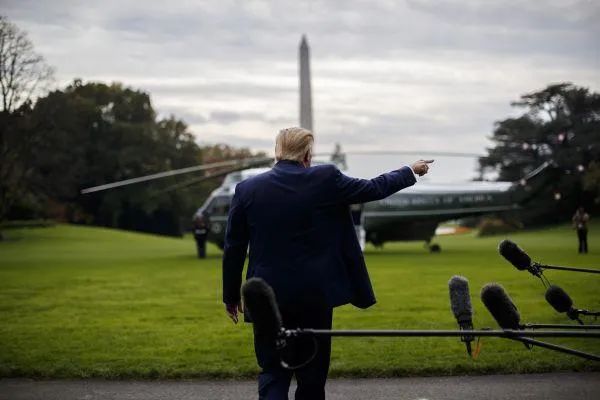Discriminating discriminatory remarks, building a wall on the US-Mexico border, implementing a “separation of bones and blood” policy, ending the provision of “temporary protective identity”, trying to suspend the “suspended repatriation of children arriving in the United States” program, threatened to abolish “birth citizenship”, and significantly reduced the scale of refugee reception…
Since taking office in January 2017, U.S. President Trump has played the “immigrant card” to fulfill his campaign promise and signed hundreds of immigration-related executive orders.
Some of these policies have been strongly questioned and criticized, revealing the true appearance of the humanitarian “halo” of the United States.
Bone and flesh separation
In June 2018, a photo of a two-year-old girl crying loudly touched the hearts of the world.
After illegally crossing the border with her mother to the United States, the girl from Honduras was arrested by law enforcement officials and faced the danger of being forced to separate from her mother.
In April 2018, the Trump administration began implementing a “zero tolerance” policy against illegal immigrants.
Under this policy, border law enforcement officials forcibly separate minors from their parents or guardians and place them separately after arresting them.
Their parents or guardians are concentrated, facing trial and even repatriation.
This scene was “moved” to the cover of Time magazine in the United States.
Trump and the Honduran girl who looked down and cried, big and small, tall and short, with a small line next to it: “Welcome to America!”
Under strong domestic and foreign pressure, Trump had to stop this policy in June of that year.
According to official statistics in the United States, in just three months, a total of 2,737 immigrant children have been forced to separate from their relatives, some even babies under one year old.
In this group, some people never return to their parents.
U.S. media revealed that 545 children had not found their parents as of October 2020 because most children’s parents had been repatriated.
Mario Ohda, a researcher at the Latin American Research Center of the National Autonomous University of Mexico, pointed out that the biggest “toxic legacy” of Trump’s four years in office is the “extreme contempt for human rights”, and the immigration policy pursued reflects “bright racism”.
Output virus
In May 2020, during a video conference of the Atlantic Council, a US think tank, Guatemalan President Jammato said emotionally: “It is not true to say any allies.
Guatemala regards the United States as an ally, but the United States does not regard Guatemala as an ally.
Jammata’s fire is that the United States intends to repatriate illegal immigrants to Guatemala despite the rapid spread of the coronavirus epidemic, and has not done any testing and protection work throughout the whole process.
On March 26, 2020, a U.S. repatriation immigration flight arrived in Guatemala.
Of the 42 people on board, 24 people were finally diagnosed with the novel coronavirus.
At that time, the number of confirmed cases in Guatemala was less than 30.
In addition, Haiti, Jamaica, Colombia and other countries have also reported the discovery of COVID-19 cases on repatriation flights to the United States.
In a question from the U.S. Congress, immigration and customs enforcement officials admitted that illegal immigrants were not routinely tested before sending them to repatriation flights.
The New York Times commented in an article that as the country with the worst epidemic, the large-scale repatriation of illegal immigrants in the United States is to spread the virus to countries outside the United States, especially Latin American countries.
Ojeda said that the repatriation of illegal immigrants to Latin American countries with weak health systems during the severe epidemic not only did not meet the requirements of health and epidemic prevention, but also was also “inhumane”.
The effect is doubtful.
On January 12 this year, outgoing Trump went to the U.S.-Mexico border city of Alamo, Texas, to inspect the U.S.-Mexico border wall that he vigorously promoted during his tenure.
For four years, there has been continuous disputes over the wall.
As early as the 2016 campaign, Trump repeatedly described illegal immigrants as “drug dealers” and “rapists”, and then proposed to build a “big and beautiful wall” aimed at curbing illegal immigrants, and absurdly demanding that Mexico “pay the bill”.
This provocation aggravated the relationship between the United States and Mexico for a time.
After forcing Mexico to “pay” for the wall to no avail, Trump threatened to impose tariffs and ordered Mexico to intercept illegal immigrants from Central America.
At the same time, pressure was put on to make Guatemala, Honduras and El Salvador “safe third countries” to pass on the immigration crisis.
The immigration policy of the United States is constantly tightening, but it has not been effective in combating illegal immigration.
According to the statistics of the Research Service of the United States Congress, the number of illegal immigrants in the United States has not decreased since the construction of the U.S.-Mexico border wall began.
The Daily Mexico has published an editorial saying that a series of immigration policies of the Trump administration are “terrorism”.
Diaz, a professor at the National Autonomous University of Puebla in Mexico, pointed out that the immigration crisis on the U.S.-Mexico border is a microcosm of the U.S. government’s expatriarchy and anti-immigrant policy.



